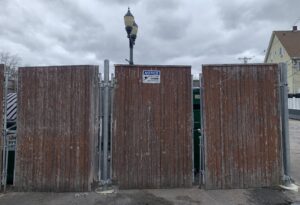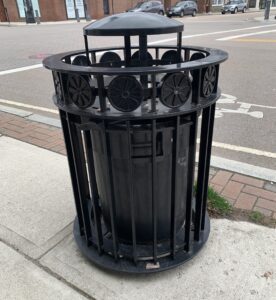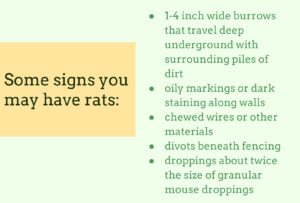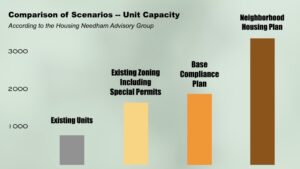
Yes, Rats Live in Needham
April 8, 2024
• Rat sightings are on the rise in Needham, causing residents to employ pest control methods and public health personnel to respond.
Rats reliably reside in non-human spaces at non-human times. The nocturnal creatures are known to frequent sewers, dumpsters and other areas to remain in the shadows.
But in recent years, rats and humans are spotting each other much more, including in Needham.
Needhamites who have never seen rats are reporting encounters, whether on a stroll through town or in their own backyard. Accounts from public health authorities and residents appear to indicate the rat population in Needham is more visible than before, and left unchecked, it could only get worse.
A Growing Trend
During the early pandemic years, rodents were of little concern. The Needham Public Health Department received just one complaint about the pests in 2020 and none in 2021 — before that, three rat complaints were filed in 2019.
However, that’s changed in the years since: residents logged six rat reports in 2022, seven in 2023 and five in just the first three months of 2024, some from multiple people. In early March, several homeowners on Longfellow Road reported rat activity, including chewed wires, captured rats and deceased ones. The most recent complaint came from Kearney Road, where someone observed a dead rat in a parking lot.
Rats were largely considered a “non-issue” five to 10 years ago, said Sai Palani, an environmental health agent with Needham Public Health. The department is working to identify sources, he said. Though rat sightings may have increased, authorities have not quantified it as a problem.

“We’ve noticed that there seems to be a pattern where they’re along the train tracks, which just makes sense,” Palani said. “It’s along the center of town, there’s lots of restaurants nearby, and then that could be a potential source.”
When the pandemic hit, Boston restaurants closed and left their food inside, welcoming pests like rats inside, but once businesses reopened, the rats seemingly dispersed. Palani said a similar, smaller-scale version of that could have taken place in Needham.
Human activity and home renovations may also be to blame for an uptick in the rat population in town, Palani said.
“The town’s growing and becoming more urbanized, and I think as that happens, there’s more trash, there’s more human activity,” he said, “and that also creates environments where rats can or pests can thrive.”
Public Health Zoologist Richard Pollack, who lives in Needham, pointed to poor sanitation and rats’ attraction to food odors as causes for rat sightings. He said he has seen torn-up trash bags in town, possibly by rats.
Pollack works as a senior environmental public health officer at Harvard University and said the rat issue is not new for cities like Boston and Cambridge, but it’s recently been rippling throughout the region, Needham included.

The portability of food is also a factor — trash and recycling trucks enable rats to “go and see the world,” Pollack said.
Shannon Nelligan, assistant director of Building Maintenance, said they tend to have more wildlife sightings at Sunita Williams Elementary School, which abuts wetlands, as well as at the Needham Recycling and Transfer Station. Mice are most common, she said.
“What tends to happen a lot at the RTS is that rats get into trash, and trash gets into the trucks, and the trucks go to the RTS, and then we see sightings there,” Nelligan said. “Obviously, the rats are gonna go to where there’s a food source.”
Echoing Palani, Pollack said during the pandemic, rats ate through undisturbed dumpsters, leading them to move to residential areas for more sources of food. On his own walks through Needham, Pollack said he’s spotted “new and increased evidence of rats,” especially around businesses.
“We’re seeing now in Needham what I have been seeing for more than a decade, what people would have seen for over a century, in our more built-up urban areas,” Pollack said.
When the problem starts, it’s hard to stop, Pollack said.
“It’s very, very difficult to suppress rat populations once they have established,” he said. “They’ll just keep growing as long as there’s food.”
Restaurant Blue on Highland sits across the street from the Needham Heights MBTA station, but Operating Partner and COO Scott Drago wrote via email they have not seen any rodent activity nearby. Bait stations by the dumpster “have had light activity but not specific to Mice or Rats,” he wrote, specifying that coyotes can frequent the area.
Resident Woes
One Needham resident’s war with the rats began last June, when she spotted rodents — either mice or rats, she wasn’t sure — burrowing under the fence into her yard. Pest control confirmed her rat problem, which kicked off costly visits to control the population.
The summer heat only worsened matters, and the resident was paying $100 weekly for experts to bait and trap with poison. She spoke to Needham Local anonymously, fearing how others may judge her pest control methods.

“I would be sitting out on my back patio, and I would just see rats run by, so it wasn’t fun to sit out there,” she said. “I was always on edge like, ‘OMG when are we going to get rid of these rats?’”
In just under a year, she said they’ve caught between 25-30 rats, including two in the same week recently. Living near the town center may be contributing to the problem, the resident added, and she feels someone else should be footing her pest control bills because “it’s not something that we caused.”
“I think everyone, all the businesses, need to do their part,” she said, “and keep their dumpsters clean, make sure they have pest control.”
Her pest control company informed her that the rat boxes, the small bait stations that trap rodents, are the best course of action. She had considered installing a rat wall, which would block rats with a mesh net under her porch, but the $20,000 price tag was not appealing, she said, and the rats would likely disperse elsewhere.
Others speak more openly about their encounters with rats. The rats are a public health concern for Aimee English, a Needham resident who said her dog recently killed a rat outside. On a separate occasion, her dog got into a rat burrow, where “pretty much the whole crew was killed by him,” English said.
English’s rat situation, comparatively, could be worse, but she too contracted pest control starting last summer. A status report in March showed all of the poison in her rat boxes had been eaten, she said. English specified the rat poison should not harm dogs, but she still remains fearful of its possible impact.
English occasionally treats for mice, but when she does, it’s deemed a success, she said. It’s much different with rats, and it’s taking a toll in other areas of her life.
“It’s also impacted family relations and finances,” English said. “I don’t have a lot of phobias, but I just cannot bear these little… It’s gross.”
English also feels the cost of her rat problem should fall on someone else, but she understands there are larger consequences to that.
“But how expensive is whatever it might be that can really get rid of this?” English said. “Because it’s all over Needham, and it’s not just downtown.”
Suzanne Donahue, who lives on Carey Road in Needham Heights, said the rodent issue is of particular concern in her part of town. Donahue’s pest control company — who conduct routine maintenance at her home — allegedly told her that vacant buildings could serve as a prime location for rodents, she said.
While Donahue herself hasn’t seen a rat in her neighborhood, her neighbors have shared their own stories — one said her dog came into contact with a rat, Donahue said.
“It kind of makes me nervous now that there’s two cases right in my neighborhood in the last month,” Donahue said.
Remediation
Needham’s Integrated Pest Management is a two-tiered system: Parks and Forestry deals with landscape concerns, such as common garden pests and weeds, while Building Management tackles town-owned buildings, which more typically deal with cockroaches, ants and rodents, according to the IPM page of the town’s website. Public Health handles town parking lots and takes down pest reports.
One of Needham’s IPM policy goals is to “reduce the use of pesticides through common sense principles of IPM,” the website states.
Parks and Forestry Superintendent Ed Olsen never deals with rats on the job, but he told Needham Local he recently spotted two along Highland Avenue in the past few weeks. Olsen said he’s lived in town for about 20 years and doesn’t remember ever seeing a rat prior.
“It is weird to see them,” Olsen said.
Michael Malvosco, assistant superintendent of Parks and Forestry, wrote in an email that parks and fields in Needham do not usually have rats and that the department does not treat for them.
Needham Building Management contracted Eco Systems — which was recently acquired by Modern Pest Services — to assist with pest control in town buildings and specifically parking lots for rodents. Needham receives standard coverage, and the company employs traditional methods, including bait boxes with rodenticide “to essentially poison and knock down the population and control it,” said Matthew Bray, vice president of sales at Modern Pest Services.
That’s how pest control has almost always functioned, Bray said, but non-toxic options are now at their disposal. Sensors, infrared technology and single-catch traps can more sustainably mitigate rodent populations, but cities and towns interested in humane methods may need to stretch their budget, Bray said.
“Rodenticide is still extremely safe as a whole, but it’s still a poison,” Bray said. “If a rat eats some poison and dies, and a bird eats the rat, then that could potentially be a problem.”
In Pollack’s opinion, rodenticide should probably only be used by licensed pest control operators, and there are limited situations in which it makes sense for the poison to be used, such as for public health. In an unoccupied building overcome by a rat infestation, Pollack supports its short-term use, but not in an occupied residential home.
Under the town’s current contract, Modern Pest Services deals with rats, mice, bees, centipedes, cockroaches and other insects. They’ll also handle mammals such as skunks and raccoons specifically at the RTS.
The company now serves at least three dozen residents in Needham, Bray said, and Massachusetts has experienced “a huge growth” of rats.
Bray also validated the concern around overdevelopment — rats tend to gravitate toward building projects, since they can hide away from humans and other predators, he said. When humans push wildlife out of their natural habitat, rats find other places to go.
“Rats are funny. They are some of the most adaptive creatures on earth, they’re incredibly intelligent, incredibly resilient, very, very wise in terms of how they pick and plan where they want to be,” Bray said. “Anytime that their safe area is disturbed, that’s when they’re going to immediately go out to seek new refuge. They don’t just stay put and be killed, they move.”
Prevention

Keeping trash containers closed with tight-fitting lids, preventing standing water and making compost bins inaccessible are major ways to keep rats out, Palani said. He also recommends pest control companies check restaurants monthly.
Pollack criticized the wrought-iron trash receptacles in Needham parks, which he called “absolutely horrendous,” as they do little to exclude pests. Rats can leap three to four feet from a standing start, he said.
“We have to do a better job of securing our trash, and I think if that was done throughout the community, that would make a measurable change,” Pollack said. “We would still have rats, but they wouldn’t be thriving to the same extent.”
Donahue, the Needham Heights resident, said the town could and should do more to inform residents and business owners and encourage them to maintain their properties.
“I do think there’s a public service side of this, and if there’s empty buildings around town, I think that they should absolutely request that the property owner or the manager take a walk through and see if there’s evidence of anything and then take the appropriate action,” Donahue said. “They can’t ignore it because I would think if you leave all these rats and mice to their own devices, just think of how many more babies can be born.”


